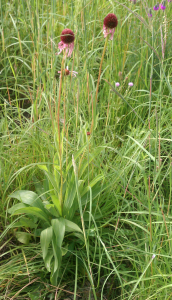This summer, we remeasured plants in experimental plot 7 at Hegg Lake. These plants are hybrids of Echinacea angustifolia (native) and Echinacea pallida (non-native, but planted at a nearby restoration). Shona Sanford-Long performed these crosses in 2012, Jill Pastick germinated the seeds that winter, and Stuart planted the seedlings the following spring. It is not yet known how the introduction of this non-native species will affect local Echinacea angustifolia populations. The survival rates and reproductive fitness of these plants can tell us how well the hybrids can compete with the native species. We have returned to the plot each of the last three years and measured the plants found there.
198 of the original 294 planted seedlings (67.3%) were found this year. The table below shows the fate of each cross-type in 2016 — the first name in the cross type is the maternal species, and the second name is the paternal species (e.g., ‘ang_pal’ is angustifolia mother and pallida father). These plants were measured on August 3rd and rechecked on September 2nd. No plants flowered this year, meaning that we must wait longer to assess seed set and reproductive fitness.
Cross Type
Found16 ang_ang ang_pal pal_ang pal_pal
no 34 10 20 32
yes 37 21 65 75
Start year: Crossing in 2012, Planting in 2013
Location: Hegg Lake Wildlife Management Area – Experimental Plot 7
Overlaps with: Echinacea hybrids: ex Pt 6; Echinacea hybrids: ex Pt 9
Data collected: Rosette number, length of all leaves, herbivory for each plant collected electronically and exported to CGData. Recheck information for plants not found was also collected electronically and stored in CGData.
Products: Taylor Harris’s 2015 poster demonstrating fitness benefits of pallida parenthood.
You can find more information and links to previous flog entries involving experimental plot 7 on the background page for the experiment.


Leave a Reply